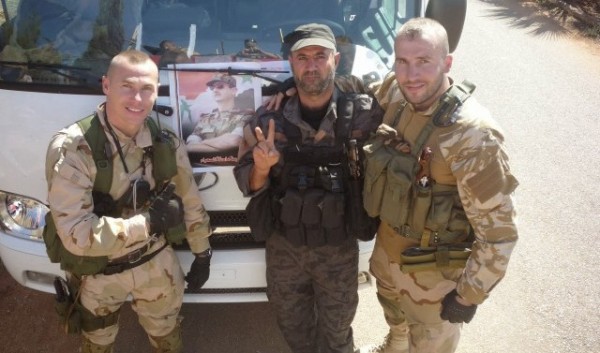PHOTO: Russian military contractors in Syria, December 2015
In December 2015, I wrote a report on the Syrian crisis for GSDRC, which provides analysis for Governments, the UN, financial institutions, and NGOs on international issues such as conflict, governance and development.
The report has now been published on the GSDRC website.
While some of the conditions inside Syria have changed — such as success for the foreign-led regime offensive, enabled by Russian bombing, in the northwest and the start of Kurdish attacks on rebels in northern Aleppo Province — I believe the assessment of the effects in the country and the region is still pertinent.
So are the conclusions: “Humanitarian aid can be no more than a minimal palliative if it is not part of a political process which — at the least — leads to protected zones, guaranteed access for aid, and security for aid providers.”
The linked Russian political-military initiative in Syria — with a bombing campaign from 30 September, support of Iranian-Hezbollah-Syrian military ground offensives, and convening of international conferences to try and secure the Assad regime –– has changed the dynamics of the five-year Syrian conflict. The effects of the intervention are significant, and are both country-specific, inside and outside Syria, and in the relationship between countries, communities, and systems.
The Russian-supported offensives have made limited gains against both rebels and the Islamic State. However, the military effects of the intervention are unlikely to be decisive despite extensive bombing, the supply of advanced battlefield equipment and armour, and the deployment of troops as “advisors” near the frontlines. Instead, Moscow is likely to face a choice as to whether it steps up its commitment, including additional bases further inside Syria, the use of more long-range bombers and cruise missiles, and the incursion of more ground forces.
Politically, the Russian initiative has achieved the immediate goal of a short-term international acceptance of President Assad’s stay in power and the removal of any reference to his future in plans for an 18-month transition. However, it is unlikely – despite a parallel, high-profile effort by the US – that a political resolution will be achieved, given the gap between the regime and Syrian opposition and rebel groups, as well as scepticism and countering moves by countries such as Saudi Arabia and Turkey.
Given this lack of resolution, the most significant effects on countries in the region and beyond are likely to be ongoing political, economic, and social challenges and costs. These will vary according to the level of involvement in and proximity to the Syrian conflict.
The Russian intervention has already expanded Turkey’s front-line political involvement, particularly after the Turkish downing of a Russian warplane near the Turkish-Syrian border on November 24. Saudi Arabia is also stepping up its involvement as the supporter of Assad’s opponents, both publicly through the attempt to foster an opposition-rebel bloc, and privately through supplies to rebel factions. Iran’s investment in – and costs from – the conflict have accompanied Russia’s intervention, particularly through the injection of front-line commanders and troops, Iran’s leadership of Hezbollah units and foreign militias, and its diplomatic insistence on Assad’s retention of power.
Other countries have been more cautious in their political positioning. The Iraqi Government has hosted a “coordinating center” for Russian, Iranian, and Syrian officials, but is otherwise maintaining a concentration on the Islamic State inside Iraq. Jordan and Lebanon are constrained by concerns over further ‘spillover’ of the conflict, while Gulf states are both deferential to the Saudi lead and wary of any stance countering it. This caution is compounded by economic and social priorities. Both Lebanon and Jordan face further challenges with large populations of Syrian refugees because of cuts in international funding, which are likely to continue into 2016, and –– in Lebanon’s case –– local violence between security forces and factions near the Syrian border.
Despite a US Government effort for a political resolution by the end of March 2016, there is unlikely to be any change in this situation without substantial changes in the approach to interaction and negotiation. These include the recognition of territorial control by each side – the Assad regime, the opposition/rebels, and Kurdish groups – in the conflict. The de facto partition offers space for the consolidation of conditions for discussion, such as the development of capacity building in opposition-held areas for governance, judicial systems, reconstruction, and provision of services.
States and actors must confront humanitarian crises in the interim period, but humanitarian aid can be no more than a minimal palliative if it is not part of a political process which — at the least — leads to protected zones, guaranteed access for aid, and security for aid providers.

